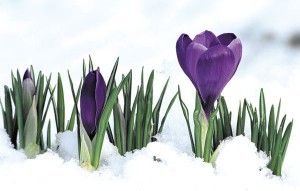“You might think that after thousands of years of coming up too soon and getting frozen, the crocus family would have a little sense knocked into it.” — Robert Benchley (1889-1945)
Crocuses (crocus, singular) are one of the first flowers to bloom in the spring and can often be seen flowering in the snow. They bear cup-shaped solitary flowers which taper off into a narrow tube. Predominate colors of their flowers are lilac mauve, yellow and white and their grass-like leaves show a central white stripe.
They grow from corms planted in the fall and are native to the woodlands, scrub and meadows of central and southern Europe and the Middle East. There are over 80 species of crocuses, and also grow in Central Asia and western China.
Crocuses were first cultivated and harvested for saffron (obtained from the stigmas of C. sativus and autumn-blooming species) on the Island of Crete. By the 1560’s they were commonplace flowers in the Netherlands and by the year 1620 they were the subject matter of works of art.
In classical Greek mythology Crocus was a moral youth, who because he was unhappy with his love affair with the nymph Smilax was turned into a plant.
Vivid orange-yellow Crocus flavus (1665) can be found growing at the Benton House Historic Garden, 316 South Downey Ave.
Within a few weeks the warming rays of the sun will entice the flowers of hellebores (Lenten Rose) into bloom.
Due to the work of ardent hybridizers, their drooping, bell-shaped flowers are available in a wide range of colors including slate-grey near-black, deep purple and plum, through rich reds and pinks to yellow, white and green.
Their flowers have five petal-like sepals and cup-like nectarines. The genus originated in Europe and Asia and a great number of the 22 species of this plant can be found growing in the Balkans.
A few are native to western China and one to the border lands between Turkey and war-torn Syria.
One species, H. foetidus, can be seen at the Benton House Historic Garden. This species has succulent stems and glossy evergreen leaves with yellowish-green flowers. Common names for this specimen include “stinking hellebore,” “dung wort,” “setter wort,” and “bear’s foot.”
Unlike other species in the hellebores genus, the nectarines of H. foetidus are colonized by yeasts which raise the temperatures of the flowers which then attract pollinators.
Hellebores prefer deep moist, humus, and dappled shade.
The Greek physician, Hippocrates (C 460-370 BC), used fluids of the plant as a purgative. An overdose of the juice of hellebores in believed to be the cause of the death of Alexander the Great.
Ed Myers is a past President of the Irvington Garden Club and the Garfield Park Master Gardener Association.He is Steward of both the Benton House and Kile Oak Habitat gardens. He may be reached by email at EMyers3670@aol.com



